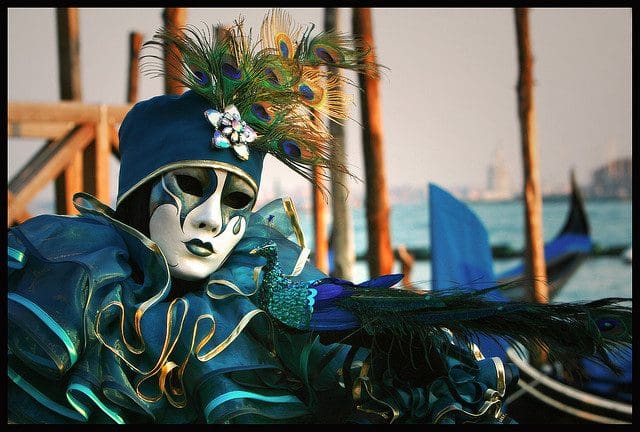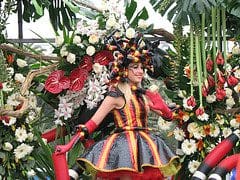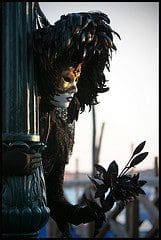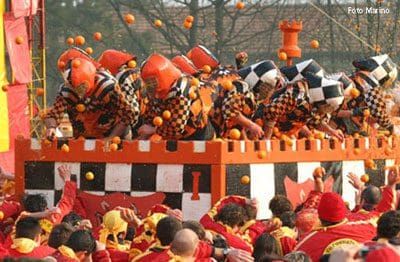
Carnival is celebrated in many places throughout the world. The big event is held on Shrove Tuesday or Fat Tuesday, which is 40 days before Easter and is the last party before Ash Wednesday and the more somber period of Lent. Because it is tied to the date of Easter, Carnival can occur anytime from early February through early March. This year, Shrove Tuesday is March 8, but in 2012 it falls on February 21 and the following year February 12. Here are some of the most popular Carnival celebrations in Europe, but a word to the wise: if you plan to attend any of the more famous celebrations, make reservations up to a year in advance to secure accommodations in the thick of the action.
Viareggio Carnival– Viareggio, on the beautiful coast of Tuscany, throws one of the liveliest Carnevale parties in Italy. The celebration runs for three weeks before Fat Tuesday with concerts, masked balls, and cultural events. On Sundays throughout the carnival season, vibrant parades march through the streets. Viareggio has become known for their huge allegorical paper maché floats. The floats are works of art that satirize politicians, entertainers, and intellectuals and take a full year to build. Masqueraders in vibrant costumes march alongside and children riding the floats throw confetti into the crowds. There is a fee to view the parades but it is well worth the unforgettable experience.

Nice Carnival– With recorded celebrations dating back to 1294, Nice France can lay claim to having the one of the oldest, if not the original Mardi Gras festival. It runs for 10 days and attracts over a million people to the spectacular events. A highlight is the flower parades that run everyday or evening. Fabulous flower-covered floats roll along while elaborately costumed people throw 100,000 flowers to the crowds. Reserved standing areas along the Promenade des Anglais provide the best viewing. The final Grande Parade, bonfire, and fireworks are a spectacular finale.

Carnevale di Venezia – Venice, Italy holds one of the most famous carnival celebrations in the world. It dates back to the 15thcentury, but was banned in the 1930’s by Mussolini, then revitalized in the 1970’s. The tradition of wearing masks began as a way to protect the identity of both nobility and commoners who mixed in the transgressions of revelry. The 10 days leading up to Carnivale is full of balls, street entertainment, traditional sweets, and of course, elaborate masks and costumes. Festivities occur nightly throughout this unique city, but St. Mark’s Square is the central beehive of activity, filled with posers and gawkers.
Spain Carnival – Barcelona, Spain celebrates Carnival in the streets with tortilla-making competitions, spicy sausages and the coveted golden pepper award. On Saturday before Fat Tuesday, the pinnacle of celebration is the Gran Rua de Carnaval, a huge parade of decorated carriages, carnival groups on foot and tons of confetti. The Carnival celebrations cease with a mock funeral as the King of Carnival has died and the fun is buried. A cortege dressed in black snakes through the streets mourning the passing.
Cologne Carnival– Cologne, Germany throws a street party for a million spectators every year, making it one of the largest in Europe. Running from Thursday to Ash Wednesday, there are city sponsored parades and stage shows, but many local bars and clubs hold private events as well. Traditionally a Prince, a Virgin, and a Farmer are designated and represent the personification of Carnival, the City of Cologne, and patronizing mother Colonia, respectively. Throughout the week-long “crazy days” festivities, people wear masquerades, greeting one another with “Cologne alive!”

Ivrea Orange Throwing Carnival – Near Turin, Italy, this town has one of the more unique ways of celebrating carnival. Born from medieval roots, the custom includes bringing carts of oranges into town about a month before Fat Tuesday. Sunday through Tuesday of Carnevale, red hats are donned and colorful parades are followed by an orange-throwing battle among anyone who chooses to participate. Keeping the red hat on signals that you are not participating in the fray, but if you are near the action you are still likely to get juiced, though not directly hit. The closing event is the burning of the scarli, which are big poles covered with dry bushes.
Carnival of Binche – Located a few miles from Brussels, Belgium, the town of Binche is on the UNESCO World Heritage List and they know how to have a party. It actually starts 49 days before Lent, but the last three days are the main event. About a thousand men and boys portray characters known as the Gilles throughout the season. They are dressed in red and black, ostrich feather hats, and wax masks with curled mustaches and glasses. On Fat Sunday there is a “Mam’selles” parade, Monday brings a huge confetti battle, and on Fat Tuesday the Gilles are out in force, dancing fancy footwork in the streets. Carnival comes to a close that night with a final fireworks display.
To take part in any of these celebrations, be sure to contact Covington Travel’s expert Vacation Advisors.







[…] Travel Maestro […]